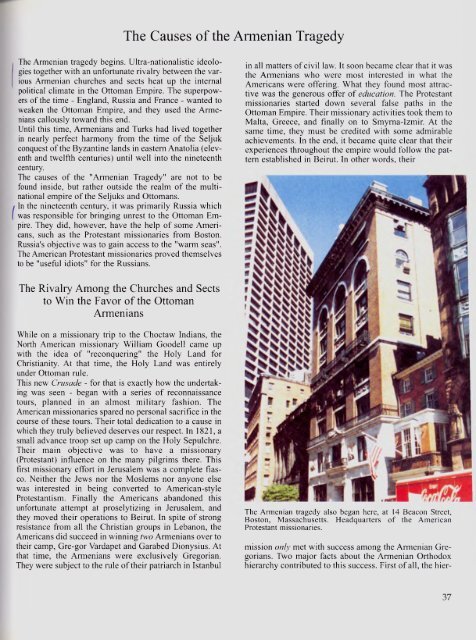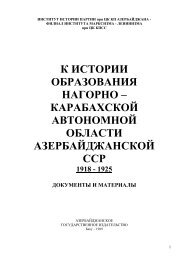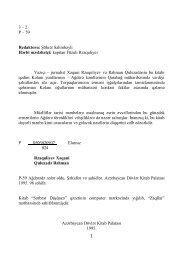ARMENIAN - Erevangala500
ARMENIAN - Erevangala500
ARMENIAN - Erevangala500
You also want an ePaper? Increase the reach of your titles
YUMPU automatically turns print PDFs into web optimized ePapers that Google loves.
The Armenian tragedy begins. Ultra-nationalistic ideologies<br />
together with an unfortunate rivalry between the various<br />
Armenian churches and sects heat up the internal<br />
political climate in the Ottoman Empire. The superpowers<br />
of the time - England, Russia and France - wanted to<br />
weaken the Ottoman Empire, and they used the Armenians<br />
callously toward this end.<br />
Until this time, Armenians and Turks had lived together<br />
in nearly perfect harmony from the time of the Seljuk<br />
conquest of the Byzantine lands in eastern Anatolia (eleventh<br />
and twelfth centuries) until well into the nineteenth<br />
century.<br />
The causes o f the "Armenian Tragedy" are not to be<br />
found inside, but rather outside the realm of the multinational<br />
empire of the Seljuks and Ottomans.<br />
In the nineteenth century, it was primarily Russia which<br />
was responsible for bringing unrest to the Ottoman Empire.<br />
They did, however, have the help o f some Americans,<br />
such as the Protestant missionaries from Boston.<br />
Russia's objective was to gain access to the "warm seas".<br />
The American Protestant missionaries proved themselves<br />
to be "useful idiots" for the Russians.<br />
The R ivalry A m ong the C hurches and Sects<br />
to W in the Favor o f the Ottom an<br />
A rm enians<br />
While on a missionary trip to the Choctaw Indians, the<br />
North American missionary William Goodell came up<br />
with the idea o f "reconquering" the Holy Land for<br />
Christianity. At that time, the Holy Land was entirely<br />
under Ottoman rule.<br />
This new Crusade - for that is exactly how the undertaking<br />
was seen - began with a series of reconnaissance<br />
tours, planned in an almost military fashion. The<br />
American missionaries spared no personal sacrifice in the<br />
course of these tours. Their total dedication to a cause in<br />
which they truly believed deserves our respect. In 1821, a<br />
small advance troop set up camp on the Holy Sepulchre.<br />
Their main objective was to have a missionary<br />
(Protestant) influence on the many pilgrims there. This<br />
first missionary effort in Jerusalem was a complete fiasco.<br />
Neither the Jews nor the Moslems nor anyone else<br />
was interested in being converted to American-style<br />
Protestantism. Finally the Americans abandoned this<br />
unfortunate attempt at proselytizing in Jerusalem, and<br />
they moved their operations to Beirut. In spite o f strong<br />
resistance from all the Christian groups in Lebanon, the<br />
Americans did succeed in winning two Armenians over to<br />
their camp, Gre-gor Vardapet and Garabed Dionysius. At<br />
that time, the Armenians were exclusively Gregorian.<br />
They were subject to the rule of their patriarch in Istanbul<br />
The Causes of the Armenian Tragedy<br />
in all matters of civil law. It soon became clear that it was<br />
the Armenians who were most interested in what the<br />
Americans were offering. What they found most attractive<br />
was the generous offer of education. The Protestant<br />
missionaries started down several false paths in the<br />
Ottoman Empire. Their missionary activities took them to<br />
Malta, Greece, and finally on to Smyma-Izmir. At the<br />
same time, they must be credited with some admirable<br />
achievements. In the end, it became quite clear that their<br />
experiences throughout the empire would follow the pattern<br />
established in Beirut. In other words, their<br />
The Armenian tragedy also began here, at 14 Beacon Street,<br />
Boston, Massachusetts. Headquarters o f the American<br />
Protestant missionaries.<br />
mission only met with success among the Armenian Gre-<br />
gorians. Two major facts about the Armenian Orthodox<br />
hierarchy contributed to this success. First of all, the hier<br />
37

















